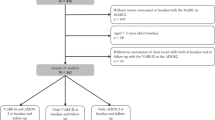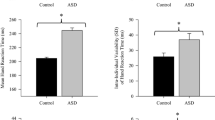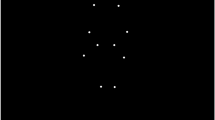Abstract
Abnormal perceptual-motor coordination is hypothesized here to be involved in social deficits of autism spectrum disorder (ASD). To test this hypothesis, high functioning children with ASD and typical controls, similar in age as well as verbal and perceptive performance, performed perceptual-motor coordination tasks and several social competence tests. Spontaneous coordination, and intentionally required in-phase and anti-phase were examined. The oscillation kinematics, as well as the accuracy and stability of spontaneous coordination were similar in both groups. In intentional coordination, ASD children produced less accurate, less stable and less complex relative phases than the control group, and in-phase and anti-phase performances that were similar in accuracy, stability, and complexity. An age-dependent relationship between socio-adaptability and coordination skills suggested these skills develop together.









Similar content being viewed by others
References
Akar, S. A., Kara, S., Latifoğlu, F., & Bilgiç, V. (2016). Analysis of the complexity measures in the EEG of schizophrenia patients. International Journal of Neural Systems, 26(02), 1650008. doi:10.1142/S0129065716500088.
Amazeen, P. G., Schmidt, R. C., & Turvey, M. T. (1995). Frequency detuning of the phase entrainment dynamics of visually coupled rhythmic movements. Biological Cybernetics, 72(6), 511–518. doi:10.1007/BF00199893.
American Psychiatric Association Diagnostic and Statistical Manual of Mental Disorders (DSM-IV). (2011). In SpringerReference. Berlin/Heidelberg: Springer. Retrieved from http://www.springerreference.com/index/doi/10.1007/SpringerReference_179660.
Banerjee, A., Tognoli, E., Kelso, J. A. S., & Jirsa, V. K. (2012). Spatiotemporal re-organization of large-scale neural assemblies underlies bimanual coordination. NeuroImage, 62(3), 1582–1592. doi:10.1016/j.neuroimage.2012.05.046.
Batschelet, E. (1981). Circular statistics in biology. London, New York: Academic Press.
Belmonte, M. K., Allen, G., Beckel-Mitchener, A., Boulanger, L. M., Carper, R. A., & Webb, S. J. (2004). Autism and abnormal development of brain connectivity. The Journal of Neuroscience: The Official Journal of the Society for Neuroscience, 24(42), 9228–9231. doi:10.1523/JNEUROSCI.3340-04.2004.
Bogdašina, O. (2005). Sensory perceptual issues in autism and Asperger syndrome: Different sensory experiences—Different perceptual worlds ((4). impression). London: Kingsley.
Bosl, W., Tierney, A., Tager-Flusberg, H., & Nelson, C. (2011). EEG complexity as a biomarker for autism spectrum disorder risk. BMC Medicine, 9(1). doi:10.1186/1741-7015-9-18.
CDC (2016). Autism spectrum disorder: Data & statistic. Center for disease and control prevention. Retrieved from https://www.cdc.gov/ncbddd/autism/data.html.
Chamak, B., Bonniau, B., Oudaya, L., & Ehrenberg, A. (2011). The autism diagnostic experiences of French parents. Autism: The International Journal of Research and Practice, 15(1), 83–97. doi:10.1177/1362361309354756.
Cirelli, L. K., Wan, S. J., & Trainor, L. J. (2014). Fourteen-month-old infants use interpersonal synchrony as a cue to direct helpfulness. Philosophical Transactions of the Royal Society B: Biological Sciences, 369(1658), 20130400–20130400. 10.1098/rstb.2013.0400.
Cook, J. L., Blakemore, S. -J., & Press, C. (2013). Atypical basic movement kinematics in autism spectrum conditions. Brain: A Journal of Neurology, 136(9), 2816–2824. doi:10.1093/brain/awt208.
Dawson, G., Hill, D., Spencer, A., Galpert, L., & Watson, L. (1991). Affective exchanges between young autistic children and their mothers. Journal of Abnormal Child Psychology, 19(1), 115–115. doi:10.1007/BF00910569.
De Coster, L., Verschuere, B., Goubert, L., Tsakiris, M., & Brass, M. (2013). I suffer more from your pain when you act like me: Being imitated enhances affective responses to seeing someone else in pain. Cognitive, Affective, & Behavioral Neuroscience, 13(3), 519–532. doi:10.3758/s13415-013-0168-4.
De Luca, C., Jantzen, K. J., Comani, S., Bertollo, M., & Kelso, J. A. S. (2010). Striatal activity during intentional switching depends on pattern stability. The Journal of Neuroscience: The Official Journal of the Society for Neuroscience, 30(9), 3167–3174. doi:10.1523/JNEUROSCI.2673-09.2010.
de Marchena, A., & Eigsti, I. -M. (2010). Conversational gestures in autism spectrum disorders: Asynchrony but not decreased frequency. Autism Research, 3(6), 311–322. doi:10.1002/aur.159.
Dessing, J. C., Daffertshofer, A., Peper, C. E., & Beek, P. J. (2007). Pattern stability and error correction during in-phase and antiphase four-ball juggling. Journal of Motor Behavior, 39(5), 433–446. doi:10.3200/JMBR.39.5.433-448.
Donnellan, A. M., Hill, D. A., & Leary, M. R. (2012). Rethinking autism: Implications of sensory and movement differences for understanding and support. Frontiers in Integrative Neuroscience, 6, 124. doi:10.3389/fnint.2012.00124.
Dziuk, M. A., Gidley Larson, J. C., Apostu, A., Mahone, E. M., Denckla, M. B., & Mostofsky, S. H. (2007). Dyspraxia in autism: Association with motor, social, and communicative deficits. Developmental Medicine and Child Neurology, 49(10), 734–739. doi:10.1111/j.1469-8749.2007.00734.x.
Elsabbagh, M., Divan, G., Koh, Y.-J., Kim, Y. S., Kauchali, S., Marcín, C., et al. (2012). Global prevalence of autism and other pervasive developmental disorders: Global epidemiology of autism. Autism Research, 5(3), 160–179. doi:10.1002/aur.239.
Esposito, G., Venuti, P., Apicella, F., & Muratori, F. (2011). Analysis of unsupported gait in toddlers with autism. Brain and Development, 33(5), 367–373. doi:10.1016/j.braindev.2010.07.006.
Fischer, R., Callander, R., Reddish, P., & Bulbulia, J. (2013). How do rituals affect cooperation?: An experimental field study comparing nine ritual types. Human Nature, 24(2), 115–125. doi:10.1007/s12110-013-9167-y.L
Fitzpatrick, P., Diorio, R., Richardson, M. J., & Schmidt, R. C. (2013). Dynamical methods for evaluating the time-dependent unfolding of social coordination in children with autism. Frontiers in Integrative Neuroscience. doi:10.3389/fnint.2013.00021.
Fitzpatrick, P., Frazier, J. A., Cochran, D. M., Mitchell, T., Coleman, C., & Schmidt, R. C. (2016). Impairments of social motor synchrony evident in autism spectrum disorder. Frontiers in Psychology. doi:10.3389/fpsyg.2016.01323.
Fitzpatrick, P., Romero, V., Amaral, J. L., Duncan, A., Barnard, H., Richardson, M. J., & Schmidt, R. C. (2017). Social motor synchronization: Insights for understanding social behavior in autism. Journal of Autism and Developmental Disorders. doi:10.1007/s10803-017-3124-2.
Fournier, K. A., Hass, C. J., Naik, S. K., Lodha, N., & Cauraugh, J. H. (2010). Motor coordination in autism spectrum disorders: A synthesis and meta-analysis. Journal of Autism and Developmental Disorders, 40(10), 1227–1240. doi:10.1007/s10803-010-0981-3.
Gallagher, S. (2008). Understanding others: Embodied social cognition. In P. Calvo & T. Gomila (Eds.), Elsevier handbook of cognitive science: An embodied approach (pp. 439–452). London: Elsevier.
Gallahue, D. L., Ozmun, J. C., & Goodway, J. (2012). Understanding motor development: Infants, children, adolescents, adults (7th edn.). New York: McGraw-Hill.
Guinchat, V., Chamak, B., Bonniau, B., Bodeau, N., Perisse, D., Cohen, D., & Danion, A. (2012). Very early signs of autism reported by parents include many concerns not specific to autism criteria. Research in Autism Spectrum Disorders, 6(2), 589–601. doi:10.1016/j.rasd.2011.10.005.
Haken, H. (1983). Synergetik. Berlin, Heidelberg: Springer. doi:10.1007/978-3-642-96775-7.
Hove, M. J., & Risen, J. L. (2009). It’s all in the timing: Interpersonal synchrony increases affiliation. Social Cognition, 27(6), 949–960. doi:10.1521/soco.2009.27.6.949.
Huys, R., Daffertshofer, A., & Beek, P. J. (2004). Multiple time scales and multiform dynamics in learning to juggle. Motor control, 8(2), 188–212. 10.1123/mcj.8.2.188.
Huys, R., Perdikis, D., & Jirsa, V. K. (2014). Functional architectures and structured flows on manifolds: A dynamical framework for motor behavior. Psychological Review, 121, 302–336.
Isenhower, R. W., Marsh, K. L., Richardson, M. J., Helt, M., Schmidt, R. C., & Fein, D. (2012). Rhythmic bimanual coordination is impaired in young children with autism spectrum disorder. Research in Autism Spectrum Disorders, 6(1), 25–31. doi:10.1016/j.rasd.2011.08.005.
Jantzen, K. J., & Kelso, J. A. S. (2007). Neural coordination dynamics of human sensorimotor behavior: A review. In V. Jirsa & A. R. McIntosh (Eds.), Handbook of brain connectivity understanding complex systems (pp. 421–461). Berlin: Springer.
Kanner, L. (1968). Autistic disturbances of affective contact. Acta Paedopsychiatrica, 35(4), 100–136.
Kaplan, B. J., Wilson, B. N., Dewey, D., & Crawford, S. G. (1998). DCD may not be a discrete disorder. Human Movement Science, 17(4–5), 471–490. doi:10.1016/S0167-9457(98)00010-4.
Kay, B. A., Kelso, J. A., Saltzman, E. L., & Schöner, G. (1987). Space-time behavior of single and bimanual rhythmical movements: Data and limit cycle model. Journal of Experimental Psychology. Human Perception and Performance, 13(2), 178–192.
Kelso, J. A. (1984). Phase transitions and critical behavior in human bimanual coordination. The American Journal of Physiology, 246(6 Pt 2), R1000–R1004.
Kelso, J. A. S. (1995). Dynamic patterns: The self-organization of brain and behavior. Cambridge, Mass.: MIT Press.
Kelso, J. A. S. (2012). Multistability and metastability: Understanding dynamic coordination in the brain. Philosophical Transactions of the Royal Society B: Biological Sciences, 367(1591), 906–918. 10.1098/rstb.2011.0351.
Kelso, J. A. S., de Guzman, G. C., Reveley, C., & Tognoli, E. (2009). Virtual Partner Interaction (VPI): Exploring Novel Behaviors via Coordination Dynamics. PLoS ONE, 4(6), e5749. doi:10.1371/journal.pone.0005749.
Kelso, J. A. S., Dumas, G., & Tognoli, E. (2013). Outline of a general theory of behavior and brain coordination. Neural Networks, 37, 120–131.doi:10.1016/j.neunet.2012.09.003.
Kelso, J. A. S., Scholz, J. P., & Schöner, G. (1986). Nonequilibrium phase transitions in coordinated biological motion: Critical fluctuations. Physics Letters A, 118(6), 279–284.doi:10.1016/0375-9601(86)90359-2.
Kirschner, S., & Tomasello, M. (2010). Joint music making promotes prosocial behavior in 4-year-old children☆☆☆. Evolution and Human Behavior, 31(5), 354–364. doi:10.1016/j.evolhumbehav.2010.04.004.
Kostrubiec, V., Danna, J., & Zanone, P.-G. (2013). Co-variation between graphic pattern stability and attentional cost: A clue for the difficulty to produce handwritten traces. Human Movement Science, 32(5), 1010–1025. doi:10.1016/j.humov.2012.12.005.
Kostrubiec, V., Zanone, P. G., Fuchs, A., & Kelso, J. A. S. (2012). Beyond the blank slate: Routes to learning new coordination patterns depend on the intrinsic dynamics of the learner—experimental evidence and theoretical model. Frontiers in Human Neuroscience, 6, 222. doi:10.3389/fnhum.2012.00222.
Kruck, J., Baudel, S., & Rogé, B. (2013). Validation française du SCQ, In J. Kruck, S. Baduel & Roge (Eds.), Questionnaire de Communication Sociale pour le Dépistage des Troubles du Spectre Autistique. Boston: Hogrefe.
Lakens, D. (2010). Movement synchrony and perceived entitativity. Journal of Experimental Social Psychology, 46(5), 701–708. doi:10.1016/j.jesp.2010.03.015.
Launay, J., Tarr, B., & Dunbar, R. I. M. (2016). Synchrony as an Adaptive Mechanism for Large-Scale Human Social Bonding. Ethology, 122(10), 779–789. doi:10.1111/eth.12528.
Le Callenec, S., & Chapel, F. (2016). Autisme la grande enquête. Paris: Arènes.
Leary, M. R., & Hill, D. A. (1996). Moving on: Autism and movement disturbance. Mental Retardation, 34(1), 39–53.
Leinen, P., Vieluf, S., Kennedy, D., Aschersleben, G., Shea, C. H., & Panzer, S. (2016). Life span changes: Performing a continuous 1:2 bimanual coordination task. Human Movement Science, 46, 209–220. 10.1016/j.humov.2016.01.004.
Lord, C., Rutter, M., & Le Couteur, A. (1994). Autism Diagnostic Interview-Revised: A revised version of a diagnostic interview for caregivers of individuals with possible pervasive developmental disorders. Journal of Autism and Developmental Disorders, 24(5), 659–685.
Mari, M., Castiello, U., Marks, D., Marraffa, C., & Prior, M. (2003). The reach-to-grasp movement in children with autism spectrum disorder. Philosophical Transactions of the Royal Society B: Biological Sciences, 358(1430), 393–403. 10.1098/rstb.2002.1205.
Marsh, K. L., Isenhower, R. W., Richardson, M. J., Helt, M., Verbalis, A. D., Schmidt, R. C., & Fein, D. (2013). Autism and social disconnection in interpersonal rocking. Frontiers in Integrative Neuroscience, doi:10.3389/fnint.2013.00004.
Martini, R., St-Pierre, M. -F., & Wilson, B. N. (2011). French Canadian Cross-Cultural Adaptation of the Developmental Coordination Disorder Questionnaire’07: DCDQ-FC. Canadian Journal of Occupational Therapy, 78(5), 318–327. doi:10.2182/cjot.2011.78.5.7.
Maximo, J. O., Cadena, E. J., & Kana, R. K. (2014). The implications of brain connectivity in the neuropsychology of autism. Neuropsychology Review, 24(1), 16–31. doi:10.1007/s11065-014-9250-0.
McNeill, V. H. (1995). Keeping together in time: Dance and drill in human history. Cambridge, MA: Harvard University Press.
Missiuna, C., Moll, S., King, S., King, G., & Law, M. (2007). A Trajectory of troubles: Parents’ impressions of the impact of developmental coordination disorder. Physical & Occupational Therapy in Pediatrics, 27(1), 81–101. doi:10.1080/J006v27n01_06.
Moran, M. F., Foley, J. T., Parker, M. E., & Weiss, M. J. (2013). Two-legged hopping in autism spectrum disorders. Frontiers in Integrative Neuroscience. doi:10.3389/fnint.2013.00014.
Pennington, B. F., & Ozonoff, S. (1996). Executive functions and developmental psychopathology. Journal of Child Psychology and Psychiatry, 37(1), 51–87. doi:10.1111/j.1469-7610.1996.tb01380.x.
Pikovsky, A., Rosenblum, M., & Kurths, J. (2001). Synchronization: A Universal Concept in Nonlinear Sciences. Cambridge, MA: Cambridge University Press. Retrieved from http://ebooks.cambridge.org/ref/id/CBO9780511755743.
Pincus, S. M. (1991). Approximate entropy as a measure of system complexity. Proceedings of the National Academy of Sciences, 88, 2297–2301.
Pincus, S. M. (1994). Greater signal regularity may indicate increased system isolation. Mathematical Biosciences, 122(2), 161–181. doi:10.1016/0025-5564(94)90056-6.
Pincus, S. M., & Goldberger, A. L. (1994). Physiological time-series analysis: What does regularity quantify? The American Journal of Physiology, 266(4 Pt 2), H1643–H1656.
Powell, D. W., Muthumani, A., & Xia, R. (2014). Parkinson’s disease is associated with greater regularity of repetitive voluntary movements. Motor Control, 18(3), 263–277. doi:10.1123/mc.2013-0025.
Prat, C. S., Stocco, A., Neuhaus, E., & Kleinhans, N. M. (2016). Basal ganglia impairments in autism spectrum disorder are related to abnormal signal gating to prefrontal cortex. Neuropsychologia, 91, 268–281. doi:10.1016/j.neuropsychologia.2016.08.007.
Provost, B., Lopez, B. R., & Heimerl, S. (2007). A comparison of motor delays in young children: Autism spectrum disorder, developmental delay, and developmental concerns. Journal of Autism and Developmental Disorders, 37(2), 321–328. doi:10.1007/s10803-006-0170-6.
Restrepo, J. F., Schlotthauer, G., & Torres, M. E. (2014). Maximum approximate entropy and threshold: A new approach for regularity changes detection. Physica A: Statistical Mechanics and Its Applications, 409, 97–109. doi:10.1016/j.physa.2014.04.041.
Richardson, M. J., Marsh, K. L., Isenhower, R. W., Goodman, J. R. L., & Schmidt, R. C. (2007). Rocking together: Dynamics of intentional and unintentional interpersonal coordination. Human Movement Science, 26(6), 867–891. doi:10.1016/j.humov.2007.07.002.
Rosseel, Y. (2012). lavaan : An R Package for Structural Equation Modeling. Journal of Statistical Software. doi:10.18637/jss.v048.i02.
Rutter, M., Bailey, A., Lord, C., Cianchetti, C., & Fancello, G. S. (2007). SCQ : Social Communication Questionnaire : Manuale. Florence: Giunti OS.
Schmidt, R. C., Bienvenu, M., Fitzpatrick, P. A., & Amazeen, P. G. (1998). A comparison of intra- and interpersonal interlimb coordination: Coordination breakdowns and coupling strength. Journal of Experimental Psychology: Human Perception and Performance, 24(3), 884–900. doi:10.1037/0096-1523.24.3.884.
Schmidt, R. C., Carello, C., & Turvey, M. T. (1990). Phase transitions and critical fluctuations in the visual coordination of rhythmic movements between people. Journal of Experimental Psychology: Human Perception and Performance, 16(2), 227–247. doi:10.1037/0096-1523.16.2.227.
Schmidt, R. C., & Fitzpatrick, P. A. (2016). The origin of the ideas of interpersonal synchrony and synergies. In P. Passos, K. Davids & C. J. Yi (Eds.), Interpersonal coordination and performance in social systems. London: Routledge.
Schmitz, C., Martineau, J., Barthélémy, C., & Assaiante, C. (2003). Motor control and children with autism: Deficit of anticipatory function? Neuroscience Letters, 348(1), 17–20.
Schöner, G., Haken, H., & Kelso, J. A. (1986). A stochastic theory of phase transitions in human hand movement. Biological Cybernetics, 53(4), 247–257.
Schöner, G., & Kelso, J. A. S. (1988). A dynamic pattern theory of behavioral change. Journal of Theoretical Biology, 135(4), 501–524. doi:10.1016/S0022-5193(88)80273-X.
Slifkin, A. B., & Newell, K. M. (1999). Noise, information transmission, and force variability. Journal of Experimental Psychology: Human Perception and Performance, 25(3), 837–851. doi:10.1037/0096-1523.25.3.837.
Song, Y. -G., Yoo, K. -S., Park, K. -W., & Park, J. -H. (2010). Coordinative and limb-specific control of bimanual movements in patients with Parkinson’s disease and cerebellar degeneration. Neuroscience Letters, 482(2), 146–150. doi:10.1016/j.neulet.2010.07.021.
Sparrow, S. S., Cicchetti, D., & Balla, D. A. (2012). Vineland Adaptive Behavior Scales, Second Edition. Retrieved from http://doi.apa.org/getdoi.cfm?doi=10.1037/t15164-000.
Sutera, S., Pandey, J., Esser, E. L., Rosenthal, M. A., Wilson, L. B., Barton, M., et al. (2007). Predictors of optimal outcome in toddlers diagnosed with autism spectrum disorders. Journal of Autism and Developmental Disorders, 37(1), 98–107. doi:10.1007/s10803-006-0340-6.
Teitelbaum, P., Teitelbaum, O., Nye, J., Fryman, J., & Maurer, R. G. (1998). Movement analysis in infancy may be useful for early diagnosis of autism. Proceedings of the National Academy of Sciences, 95(23), 13982–13987. doi:10.1073/pnas.95.23.13982.
Temprado, J. J., Monno, A., Laurent, M., & Zanone, P. G. (2001). A dynamical framework to understand performance trade-offs and interference in dual tasks. Journal of Experimental Psychology. Human Perception and Performance, 27(6), 1303–1313.
Temprado, J. -J., Vercruysse, S., Salesse, R., & Berton, E. (2010). A dynamic systems approach to the effects of aging on bimanual coordination. Gerontology, 56(3), 335–344. doi:10.1159/000262445.
Thelen, E., & Smith, L. B. (1996). A dynamic systems approach to the development of cognition and action. Cambridge, MA: MIT Press. Retrieved from http://search.ebscohost.com/login.aspx?direct=true&scope=site&db=nlebk&db=nlabk&AN=1712.
Thelen, E., Schöner, G., Scheier, C., & Smith, L. B. (2001). The dynamics of embodiment: A field theory of infant perseverative reaching. Behavioral and Brain Science, 24(1), 34–86.
Turvey, M. T. (1990). Coordination. The American Psychologist, 45(8), 938–953.
Uddin, L. Q., Supekar, K., & Menon, V. (2013). Reconceptualizing functional brain connectivity in autism from a developmental perspective. Frontiers in Human Neuroscience. doi:10.3389/fnhum.2013.00458.
Valdesolo, P., & DeSteno, D. (2011). Synchrony and the social tuning of compassion. Emotion (Washington, D. C.), 11(2), 262–266. doi:10.1037/a0021302.
van Ulzen, N. R., Lamoth, C. J. C., Daffertshofer, A., Semin, G. R., & Beek, P. J. (2008). Characteristics of instructed and uninstructed interpersonal coordination while walking side-by-side. Neuroscience Letters, 432(2), 88–93. doi:10.1016/j.neulet.2007.11.070.
Volman, M. C. J., & Geuze, R. H. (2000). Temporal stability of rhythmic tapping “on” and “off the beat”: A developmental study. Psychological Research Psychologische Forschung, 63(1), 62–69.
Whyatt, C. P., & Craig, C. M. (2012). Motor skills in children aged 7–10 years, diagnosed with autism spectrum disorder. Journal of Autism and Developmental Disorders, 42(9), 1799–1809. doi:10.1007/s10803-011-1421-8.
Wiltermuth, S. S., & Heath, C. (2009). Synchrony and cooperation. Psychological Science, 20(1), 1–5. doi:10.1111/j.1467-9280.2008.02253.x.
Zwaigenbaum, L., Bryson, S., Rogers, T., Roberts, W., Brian, J., & Szatmari, P. (2005). Behavioral manifestations of autism in the first year of life. International Journal of Developmental Neuroscience, 23(2–3), 143–152. doi:10.1016/j.ijdevneu.2004.05.001.
Acknowledgments
The authors are grateful to all children, their parents, to the participating centers, and to Aurélie Peltier and Naïma Hilal for their help with data collection.
Author information
Authors and Affiliations
Contributions
VK, RH and JK participated in the design of the study. BJ collected the data. VK analysed the results and drafted the manuscript. All authors critically reviewed and edited the manuscript for important intellectual content, and all authors approved the final manuscript.
Corresponding author
Ethics declarations
Conflict of interest
The authors declare that they have no conflict of interest.
Ethical Approval
All procedures performed in studies involving human participants were in accordance with the ethical standards of the institutional and/or national research committee CERNI and with the 1964 Helsinki declaration and its later amendments or comparable ethical standards.
Informed Consent
Informed consent was obtained from all individual participants included in the study.
Rights and permissions
About this article
Cite this article
Kostrubiec, V., Huys, R., Jas, B. et al. Age-dependent Relationship Between Socio-adaptability and Motor Coordination in High Functioning Children with Autism Spectrum Disorder. J Autism Dev Disord 48, 209–224 (2018). https://doi.org/10.1007/s10803-017-3326-7
Published:
Issue Date:
DOI: https://doi.org/10.1007/s10803-017-3326-7




